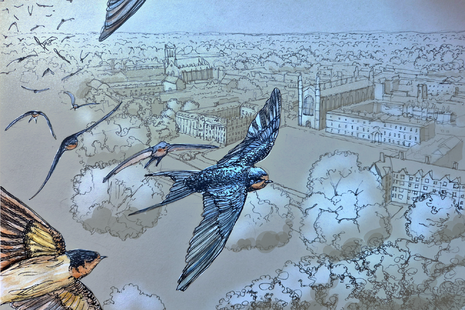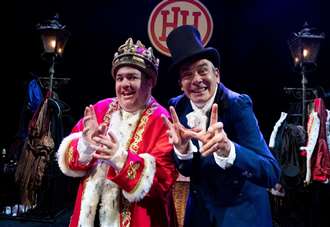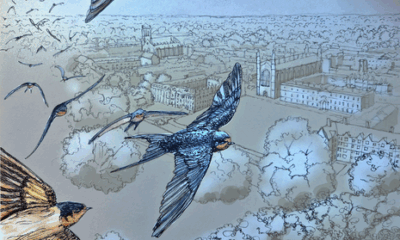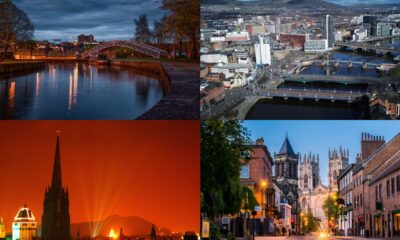Science
Birds’ Migration Insights Propel Advances in Quantum Computing

The migration patterns of birds may hold keys to breakthroughs in quantum computing, according to researchers exploring the intricate navigation methods used by these avian travelers. As autumn settles in, species such as redwings and fieldfares replace swallows and swifts in regions like Cambridge. Understanding how birds traverse thousands of miles each year could lead to innovations in technology, particularly quantum systems.
Approximately 20% of the world’s bird population migrates seasonally, flying from countries in the northern hemisphere to warmer climates during winter. For centuries, the mystery of bird migration has fascinated scientists and laypeople alike. Historically, figures like Aristotle speculated on the transformations of bird species during migration. Modern science, however, reveals that various factors guide birds on their long journeys, including visual cues and a unique sense known as magnetoreception.
Birds rely heavily on visual navigation, using landmarks such as rivers and mountains. They also employ a method akin to ancient maritime navigation, positioning themselves based on the rotation of stars around the North Star. However, the specific migration routes are often encoded in their genetics. Birds that inherit different migration paths from their parents tend to take intermediate routes, highlighting the importance of inherited knowledge in their navigation strategies.
Recent research indicates that the first migration cycle is crucial, as birds often replicate the same route throughout their lives. In addition to visual cues, birds utilize their sense of smell to recognize familiar locations. The phenomenon of magnetoreception, which is the ability to detect the Earth’s magnetic field and use it for orientation, remains poorly understood but is gradually revealing its secrets.
Two leading hypotheses explain how birds perceive magnetic fields. The first suggests that birds contain crystals of magnetite within their tissues, which could align with the Earth’s magnetic field. This theory presents challenges, as the crystals must be of a size that allows them to respond to the weak magnetic forces without experiencing friction.
The second, and more promising, hypothesis was proposed by Klaus Schulten in 1978. He posited that magnetoreception has a quantum nature. This theory involves the behavior of covalent chemical bonds, specifically how they can break either heterolytically or homolytically. When bonds break homolytically, they create free radicals with unpaired electrons that possess a property known as ‘spin.’ This spin can influence how the radicals interact with external magnetic fields, potentially allowing birds to navigate using these microscopic magnets.
Ongoing research into bird migration may not only unravel the mysteries of their navigation but could also inform the development of quantum computers. Scientists are particularly interested in a protein called cryptochrome 4, believed to play a role in birds’ magnetoreception. Insights gained from studying the unique adaptations of migratory birds could pave the way for advanced technologies.
Another intriguing aspect of avian migration is how birds manage to thrive on minimal sleep. Many songbirds engage in ‘micronaps’ that appear sufficient to maintain their physiological functions during long journeys. Although humans cannot adopt similar strategies, there is significant interest in understanding these mechanisms. The U.S. Defense Advanced Research Projects Agency (DARPA) has invested in research analyzing the neural circuits of migrating birds to explore the possibility of creating “no-sleep soldiers.”
Despite the marvels of bird migration, human activities pose challenges. A study from 2022 highlighted that bird species richness is lower in areas with wind turbines compared to control sites. This suggests that infrastructure may disrupt migratory patterns. Additionally, artificial lighting at night can lure migratory birds, leading to disorientation and increased collision risks with buildings.
As migratory birds prepare for their seasonal journeys, there is much to appreciate in their remarkable abilities. The intersection of nature and technology exemplified by bird migration could be fundamental in shaping future advancements. Continued research in this area promises to unlock further mysteries of both avian navigation and quantum technology, highlighting the intricate relationship between the two.
-

 World2 days ago
World2 days agoCoronation Street’s Shocking Murder Twist Reveals Family Secrets
-

 Entertainment4 months ago
Entertainment4 months agoKate Garraway Sells £2 Million Home Amid Financial Struggles
-

 Entertainment3 months ago
Entertainment3 months agoAnn Ming Reflects on ITV’s ‘I Fought the Law’ Drama
-

 Health3 months ago
Health3 months agoKatie Price Faces New Health Concerns After Cancer Symptoms Resurface
-

 Entertainment3 weeks ago
Entertainment3 weeks agoCoronation Street Fans React as Todd Faces Heartbreaking Choice
-

 World3 weeks ago
World3 weeks agoBailey Announces Heartbreaking Split from Rebecca After Reunion
-

 Entertainment5 days ago
Entertainment5 days agoTwo Stars Evicted from I’m A Celebrity Just Days Before Finale
-

 World5 days ago
World5 days agoKevin Sinfield Exceeds Fundraising Goal Ahead of Final Marathons
-

 Entertainment3 months ago
Entertainment3 months agoCoronation Street’s Carl Webster Faces Trouble with New Affairs
-

 Entertainment3 months ago
Entertainment3 months agoWhere is Tinder Swindler Simon Leviev? Latest Updates Revealed
-

 Entertainment4 months ago
Entertainment4 months agoMarkiplier Addresses AI Controversy During Livestream Response
-

 Science2 months ago
Science2 months agoBrian Cox Addresses Claims of Alien Probe in 3I/ATLAS Discovery





















